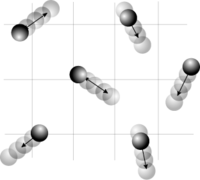
Photo from wikipedia
The total partition sum, Q(T), and its first and second moments, Q′(T) and Q″(T), were determined in terms of the total internal partition sum, Qint(T), and the translational partition sum,… Click to show full abstract
The total partition sum, Q(T), and its first and second moments, Q′(T) and Q″(T), were determined in terms of the total internal partition sum, Qint(T), and the translational partition sum, Qtrans(T), for 14N2, 14N15N, and 15N2. The total internal partition sum was computed using term values determined using the molecular constants of Le Roy et al. [J. Chem. Phys. 125, 164310 (2006)] for the ground electronic state and molecular constants for the first eight excited electronic states. The work of Le Roy et al. provides the best term values available and, hence, the most accurate total internal partition sums and their first and second moments. The convergence of Qint(T) and its moments were carefully studied and resulted in values with small uncertainty to 9000 K. From these quantities, the isobaric heat capacity, the Helmholtz energy, the entropy, the enthalpy, the Gibbs function, and the JANAF functions S0, hef, and gef, were computed on a 1 K grid from 1 to 9000 K. The resulting thermodynamic quantities are the most accurately determined from the direct summation of Q(T), Q′(T) and Q″(T). These data are compared with literature values.
Journal Title: Journal of Physical and Chemical Reference Data
Year Published: 2023
Link to full text (if available)
Share on Social Media: Sign Up to like & get
recommendations!